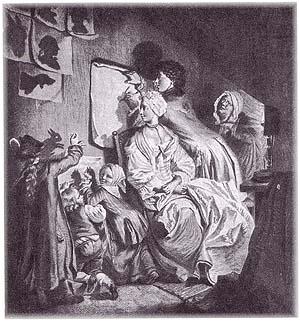Regency Letter Writing
The post-office has a great charm at one period of our lives. -Emma
Before 1840 various factors affected the cost of posting a letter. They included the distance involved, the weight, whether there was anything enclosed, whether paid for on despatch or receipt, and whether it was a single or a double sheet. Because of this last factor, the letter was written, then the page was folded and the address inscribed on the outside of the same sheet. If another page had been enclosed the cost would have doubled. The postage was usually paid by the person who received the letter, not by the sender.*
Step 1) Take a blank piece of paper and write your message. 
Dear Sir, Pray send a copy of the will of Mr Willm. Cross, of Gorbiston in Suffolk, proved about a fortnight or three weeks ago. Yrs Truly, N.B. Palmer Regent Street Gt Yarmouth 11 Nov 1823 Messrs Kitson & Backham, Norwich
Step 2) Fold the paper, keeping the message inside, so that the two ends will tuck into one another, and write the address on one of the outside panels. Messrs Kitson & Backham Norwich 
Step 3) When the address has been written, tuck the ends of the letter into one another and it is then ready to be lodged at the local post office, or to be collected by the postman.


It may be necessary to make a better seal, in which case a stick of sealing wax is heated by the flame of a candle, and held over the join of the ends of the letter. When a melted blob has dropped onto the letter, press a seal onto it, and as soon as it cools, the letter is sealed. The sealing wax was usually red, but in this case it is black.
*Members of Parliament had the priviledge of "Franking" their letters- placing on them a special stamp which exhonerated the recipiant from paying any postage. Edmund suggests this route to Fanny in Mansfield Park, "Yes, depend upon me it shall: it shall go with the other letters; and, as your uncle will frank it, it will cost William nothing."
Ron and Eunice Shanahan have collected British postal history for nearly 40 years. Though their period letters were originally purchased for the postal markings, over the years, the contents of the letters became of as much interest as the postal markings. Eunice writes for Stamp News Australasia, and has managed to sneak a fair bit of social history into the articles. The Shanahans host the Regency Postal Page.



2 comments
Thank you very much for your delightful and interesting article on Regency letter writing.
I found it most interesting that the one who received a letter was required to pay for the postage of the letter, and not the sender during the Regency period.
Who else apart from Members of Parliament had the privilege to make use of “franking” their letters?
Mr. Jonathan Morris
Hello my friend.
Our employees wrote to you yesterday maybe…
Can I offer paid advertising on your site?
FernePoili
Leave a comment
This site is protected by hCaptcha and the hCaptcha Privacy Policy and Terms of Service apply.